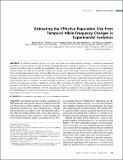Files in this item
Estimating the effective population size from temporal allele frequency changes in experimental evolution
Item metadata
| dc.contributor.author | Jónás, Ágnes | |
| dc.contributor.author | Taus, Thomas | |
| dc.contributor.author | Kosiol, Carolin | |
| dc.contributor.author | Schlötterer, Christian | |
| dc.contributor.author | Futschik, Andreas | |
| dc.date.accessioned | 2017-02-08T12:30:14Z | |
| dc.date.available | 2017-02-08T12:30:14Z | |
| dc.date.issued | 2016-10-11 | |
| dc.identifier | 249097930 | |
| dc.identifier | f4e0bc45-1102-4199-bbe9-46d7a7671069 | |
| dc.identifier | 27542959 | |
| dc.identifier | 84991501359 | |
| dc.identifier.citation | Jónás , Á , Taus , T , Kosiol , C , Schlötterer , C & Futschik , A 2016 , ' Estimating the effective population size from temporal allele frequency changes in experimental evolution ' , Genetics , vol. 204 , no. 2 , pp. 723-735 . https://doi.org/10.1534/genetics.116.191197 | en |
| dc.identifier.issn | 0016-6731 | |
| dc.identifier.other | PubMedCentral: PMC5068858 | |
| dc.identifier.uri | https://hdl.handle.net/10023/10250 | |
| dc.description | A.J. and T.T. are members of the Vienna Graduate School of Population Genetics, which is funded by the Austrian Science Fund (FWF, W1225). C.S. is also supported by the European Research Council grant ”ArchAdapt,” and T.T. is a recipient of a Doctoral Fellowship (DOC) of the Austrian Academy of Sciences. | en |
| dc.description.abstract | The effective population size (Ne) is a major factor determining allele frequency changes in natural and experimental populations. Temporal methods provide a powerful and simple approach to estimate short-term Ne. They use allele frequency shifts between temporal samples to calculate the standardized variance, which is directly related to Ne. Here we focus on experimental evolution studies that often rely on repeated sequencing of samples in pools (Pool-seq). Pool-seq is cost-effective and often outperforms individual-based sequencing in estimating allele frequencies, but it is associated with atypical sampling properties: Additional to sampling individuals, sequencing DNA in pools leads to a second round of sampling, which increases the variance of allele frequency estimates. We propose a new estimator of Ne, which relies on allele frequency changes in temporal data and corrects for the variance in both sampling steps. In simulations, we obtain accurate Ne estimates, as long as the drift variance is not too small compared to the sampling and sequencing variance. In addition to genome-wide Ne estimates, we extend our method using a recursive partitioning approach to estimate Ne locally along the chromosome. Since the type I error is controlled, our method permits the identification of genomic regions that differ significantly in their Ne estimates. We present an application to Pool-seq data from experimental evolution with Drosophila and provide recommendations for whole-genome data. The estimator is computationally efficient and available as an R package at https://github.com/ThomasTaus/Nest. | |
| dc.format.extent | 13 | |
| dc.format.extent | 5149652 | |
| dc.language.iso | eng | |
| dc.relation.ispartof | Genetics | en |
| dc.subject | Effective population size | en |
| dc.subject | Genetic drift | en |
| dc.subject | Pool-seq | en |
| dc.subject | Experimental evolution | en |
| dc.subject | QH301 Biology | en |
| dc.subject | QH426 Genetics | en |
| dc.subject | NDAS | en |
| dc.subject.lcc | QH301 | en |
| dc.subject.lcc | QH426 | en |
| dc.title | Estimating the effective population size from temporal allele frequency changes in experimental evolution | en |
| dc.type | Journal article | en |
| dc.contributor.institution | University of St Andrews. School of Biology | en |
| dc.contributor.institution | University of St Andrews. Centre for Biological Diversity | en |
| dc.identifier.doi | 10.1534/genetics.116.191197 | |
| dc.description.status | Peer reviewed | en |
This item appears in the following Collection(s)
Items in the St Andrews Research Repository are protected by copyright, with all rights reserved, unless otherwise indicated.

